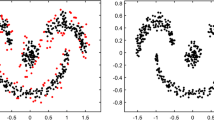Abstract
In many fields of machine learning such as classifying and clustering, neighborhood construction algorithms are used to model local relationships between data samples and to build global structure from local information. In finding connection among the data points, neighborhood is undeniably useful for data processing. Therefore, a very major issue is to find a novel approach to locating neighborhood among data points. If the geometric relationships existing between the data points in the neighborhood area are accurately explored, it will be feasible to observe the behavioral rules as well as the similarities among the data. This will also help identify indirect and direct neighborhood ranges. This study aims to find neighborhood accurately by means of the Apollonius circle zones. The experimental validation against well-known k-nearest neighbor and ε-neighborhood is also an indication of the robustness of the method in real data sets.






Similar content being viewed by others
References
Duda, R.: PE Hart and DG Stork, Pattern Classification. Wiley-Interscience, New York (2001)
Han, J., Kamber, M.: Data Mining: Concepts and Techniques. Morgan Kaufmann Publishers, San Francisco (2001)
İnkaya, T., Kayalıgil, S., Özdemirel, N.E.: An adaptive neighbourhood construction algorithm based on density and connectivity. Pattern Recogn. Lett. 52, 17–24 (2015)
İnkaya, T.: A density and connectivity based decision rule for pattern classification. Expert Syst. Appl. 42, 906–912 (2015)
İnkaya, T.: A parameter-free similarity graph for spectral clustering. Expert Syst. Appl. 42, 9489–9498 (2015)
Langerman, J.C.S.C.S.: Empty region graphs. Comput. Geom. Theory Appl. 42, 183–195 (2009)
Kirkpatrick DG, Radke JD (1984) A Framework for Computational Morphology, vol 13, pp 43–72
Tsai, W.-P., Huang, S.-P., Shao, S.-T., Cheng, K.-T., Chang, F.-J.: A data-mining framework for exploring the multi-relation between fish species and water quality through self-organizing map. Sci. Total Environ. 8, 474–483 (2016)
Singh, K., Shakya, H.K., Biswas, B.: Clustering of people in social network based on textual similarity. Perspect. Sci. 8, 570–573 (2016)
Zhou, H., Li, J., Li, J., Zhang, F., Cui, Y.A.: graph clustering method for community detection in complex networks. Phys. A 469, 551–562 (2016)
Wang, M., Zuo, W., Wang, Y.: An improved density peaks-based clustering method for social circle discovery in social networks. Neurocomputing 179, 219–227 (2016)
Arleo, A., Didimo, W., Liotta, G., Montecchiani, F.: Large graph visualizations using a distributed computing platform. Inf. Sci. 381, 124–141 (2016)
Guo, H., Yu, Y., Skitmore, M.: Visualization technology-based construction safety management: a review. Autom. Constr. 73, 135–144 (2016)
Pedrycz, W.: The design of cognitive maps: a study in synergy of granular computing and evolutionary optimization. Expert Syst. Appl. 37, 7288–7294 (2010)
Mohammadi, M., Raahemi, B., Mehraban, S.A., Bigdeli, E., Akbari, A.: An enhanced noise resilient K-associated graph classifier. Expert Syst. Appl. 42, 8283–8293 (2015)
Cai, Q., Gong, M., Ma, L., Ruan, S., Yuan, F., Jiao, L.: Greedy discrete particle swarm optimization for large-scale social network clustering. Inf. Sci. 316, 503–516 (2015)
Gong, M., Cai, Q., Chen, X., Ma, L.: Complex network clustering by multiobjective discrete particle swarm optimization based on decomposition. IEEE Trans. Evol. Comput. 18, 82–97 (2014)
Pourbahrami, S., Khanli, L.M., Azimpour, S.: Novel and efficient data point neighborhood construction algorithm based on Apollonius circle. Expert Syst. Appl. 115, 57–67 (2019)
Author information
Authors and Affiliations
Corresponding author
Additional information
Publisher's Note
Springer Nature remains neutral with regard to jurisdictional claims in published maps and institutional affiliations.
Rights and permissions
About this article
Cite this article
Pourbahrami, S., Azimpour, S. A new method for detection of clustering based on four zones Apollonius circle. Iran J Comput Sci 3, 59–64 (2020). https://doi.org/10.1007/s42044-019-00050-1
Received:
Accepted:
Published:
Issue Date:
DOI: https://doi.org/10.1007/s42044-019-00050-1




